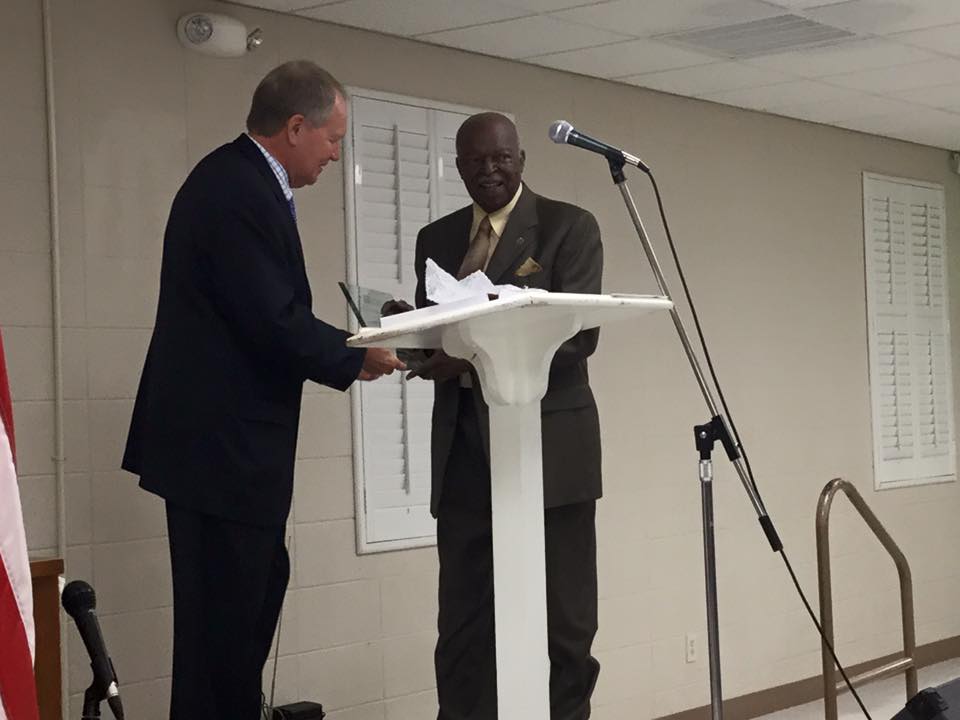

A tourism official from Corbin, Kentucky, the town that wants the old train engine in Bainbridge’s Boat Basin for a railroad museum, appeared before the Bainbridge City Council at its Tuesday meeting.
Ultimately, City Councilman Joe Sweet moved to table the issue until further discussion could be had among the council members. Citing some council members’ concern that at this point, Bainbridge would not be guaranteed any real property in exchange for allowing the train to leave, City Manager Chris Hobby said he would talk with Corbin officials about what they might be willing to negotiate in exchange for the train.
After the meeting, Councilman Sweet said he had no set opinion on the request to move the train engine. He said he shared Councilman Luther Conyers’ concern that if the train was allowed to move, it’s possible that nothing would replace the lost value of having it in the Boat Basin. However, he acknowledged “it might not be possible” for Corbin to arrange a suitable replacement for the train engine, such as another historic train car.
Maggy Kriebel of the Corbin Tourism Commission and a student intern from Eastern Kentucky University told the Bainbridge City Council about the Corbin Rail Project, or Corbin Rail Museum, which will open later this year.
Officials in Corbin have requested a transfer of the train to their city because the 2132 switcher engine was originally manufactured by the Louisville and Nashville Railroad and was formerly used at the L & N Railroad’s Corbin Yard, which connected trains into Appalachia, an area that saw a boom of coal being transported out by rail.
See related story: Coal Mining and The Louisville & Nashville Railroad In Western Kentucky
Corbin, Ky., a town of about 7,700 people, owes its existence to the Louisville and Nashville Railroad. According to Kriebel, Corbin was once home to the largest “coal wash” in the United States.
A coal preparation plant (CPP) is a facility that washes coal of soil and rock, crushes it into graded sized chunks (sorting), stockpiles grades preparing it for transport to market, and more often than not, also loads coal into rail cars, barges, or ships. (Wikipedia)
Because the railroad industry switched over to diesel power, the passage of time means here are only three Louisville and Nashville steam locomotive engines in existence, and only one remaining that was actually made by the company’s craftsmen at its yard in South Louisville, Kentucky, according to Sid Johnson, a former employee of the L & N Railroad who now resides in Florida and made the trip for Tuesday’s presentation.
If Bainbridge were to give its permission to give the train for the museum, Corbin officials want to take on the expensive project of moving it from Georgia to Kentucky and then also restoring it to “pristine” historical condition for display at the museum.
While the figures are ballpark, Kriebel said Corbin would have to pay between $75,000 and $100,000 to transport the train to Kentucky. According to Johnson, who belongs to an L & N Historical Society, it would take tens of thousands of dollars to restore the train to something close to how it originally appeared, mainly because it is badly rusted. The university student working on the Corbin Rail Project said the Federal Railroad Administration has guidelines for restoring old trains, including getting rid of any asbestos it might have on it, and treating the various surfaces of the engine, including its cab and wheels.
What’s Corbin got to offer in exchange for Bainbridge potentially allowing the train to be moved?
- Creation of a “sister city” relationship between Corbin and Bainbridge, with each city referring guests to historical points of interests in the other town, as part of tourism marketing. This would be an ongoing relationship.
- “Prominent” inclusion of Bainbridge’s role in saving the train engine from its abandoned state in Sneads, Fla., within the museum’s signage, literature and accompanying website. Bainbridge officials would also be invited to attend the railroad museum’s grand opening.
- Possible transfer of a diesel locomotive engine owned by a Kentucky railroad that is no longer in use (including talks with CSX, which also operates in Kentucky) <—At issue would be who would bear the cost of transporting said engine back to Bainbridge.
- Kriebel said they have contacted the SAM Short Line Railroad in Georgia, which has a Flint River passenger rail car that was used in Southwest Georgia. The rail car is currently used for tourist day trips near the SAM Short Line’s home in Cordele, Ga., so it’s not clear if the railroad would be willing to make trips to Bainbridge with the car or highlight Bainbridge’s history within the passenger car itself.
Bainbridge City Councilwoman Roslyn Palmer said she believed the train should be kept, that its presence in Bainbridge for almost 35 years gave it a local history, as well. She also said the train car could be used to help Bainbridge tourism, if it was properly maintained for display, and said “once it’s gone, there’s no getting it back.”
Palmer suggested that the City of Bainbridge’s situation is different from Corbin and so the goal here would not necessarily be to spend a lot of money on restoring the train to full historic preservation quality. Rather, Bainbridge could do other things to keep up the train, including rebuilding a cover shed that was destroyed by a 2013 storm, possibly building a fence around the train display to keep people off the engine, and maybe welding shut the door to the train caboose, which is in poor shape due to graffiti and trash inside it.
Bainbridge City Councilman Luther Conyers said he would not be in favor of letting the train go unless Corbin was willing to give Bainbridge something substantial in return. Even then, he questioned whether Corbin could bear the cost of transporting a replacement rail car to Georgia, given the expensive estimates on moving Bainbridge’s engine.
Councilwoman Glennie Bench said her concern was the cost Bainbridge would have to spend just to keep the train engine and caboose from falling into worse shape. For example, if a tall fence had to be placed around the train to keep out vandalism, wouldn’t that defeat some of the purpose of having it as a place people could visit, Bench asked?
Addressing Palmer, Councilman Phil Long essentially asked if it was this particular train Palmer wanted to keep, or could it be another train car reflective of that era of railroad history (which Bainbridge and Decatur County shared a part of) that could keep the cultural significance at the Boat Basin.
Several citizens commented on the train engine issue.
Frances Willis is a former assistant to the late Bainbridge Mayor Billy K. Reynolds, who helped lead a movement to get the train from Sneads, Fla. to Bainbridge. Willis is in favor of keeping the train in Bainbridge, saying she has research suggesting the train engine also was used within Decatur County for light passenger and mail service.
J.B. Swicord said he recalled seeing a train engine, possibly the 2132 engine, go past his house twice a day when he was younger. He compared the train engine to a fire truck that was near his adult home, that inspired his sons’ imagination. Swicord said that if for some reason the train engine was in the way of the planned Bainbridge River Walk project, he would be glad to donate land to display the train engine elsewhere in Decatur County.
Ted Snell, who moved to Bainbridge from New Hampshire to retire, said he hadn’t originally planned to speak on the train issue but was struck by the Corbin tourism officials’ presentation about what the 2132 engine meant to their town.
“This is a home run,” Snell said. “This is a beautiful train that is deteiorating, so I can’t believe you wouldn’t accept their offer [to restore it]. I would rather see a river boat, which has more significance to Bainbridge’s history, be brought to the Boat Basin for display. No one is coming to Bainbridge now to see a train engine, but they would if there was a river boat that had a band and a restaurant.”
Basil Lucas, who is a member of the Bainbridge Historical Society, said he didn’t see a historical connection between the train engine and the City of Bainbridge, whereas on the other hand, it had substantial connections to Corbin, Kentucky.
“I understand that there is a feeling of nostalgia and notion that it’s something interesting to look at, but personally, I would rather see a riverboat or some of the airplanes [used at the Bainbridge Air Base] on display,” Lucas said. “I also don’t think we need to spend a lot of money on [the engine.]”
Bainbridge Mayor Edward Reynolds was not present at the meeting, so Councilwoman Roslyn Palmer and Councilman Don Whaley served as mayor pro tempore at different parts of the meeting.




I am a student at Bainbridge High School and, along with a large amount of my peers, I don’t want this train gone. It’s been here for almost 35 years. My father grew up with it. I grew up with it. It’s beautiful. the train is a landmark in Bainbridge and it would not be the same without it. My 4 year-old sister loves to go there and to see it. that wonderful train is a part of my history and my father’s history. I would be disappointed if anything happened to that beautiful landmark. Save The Train.
I went to the park yesterday to see the train.And was so sad that it was gone.Now just a empty space.It added so much to the park.Miss all the machinery to.Its not much of a park anymore.Vistor from Alabama.